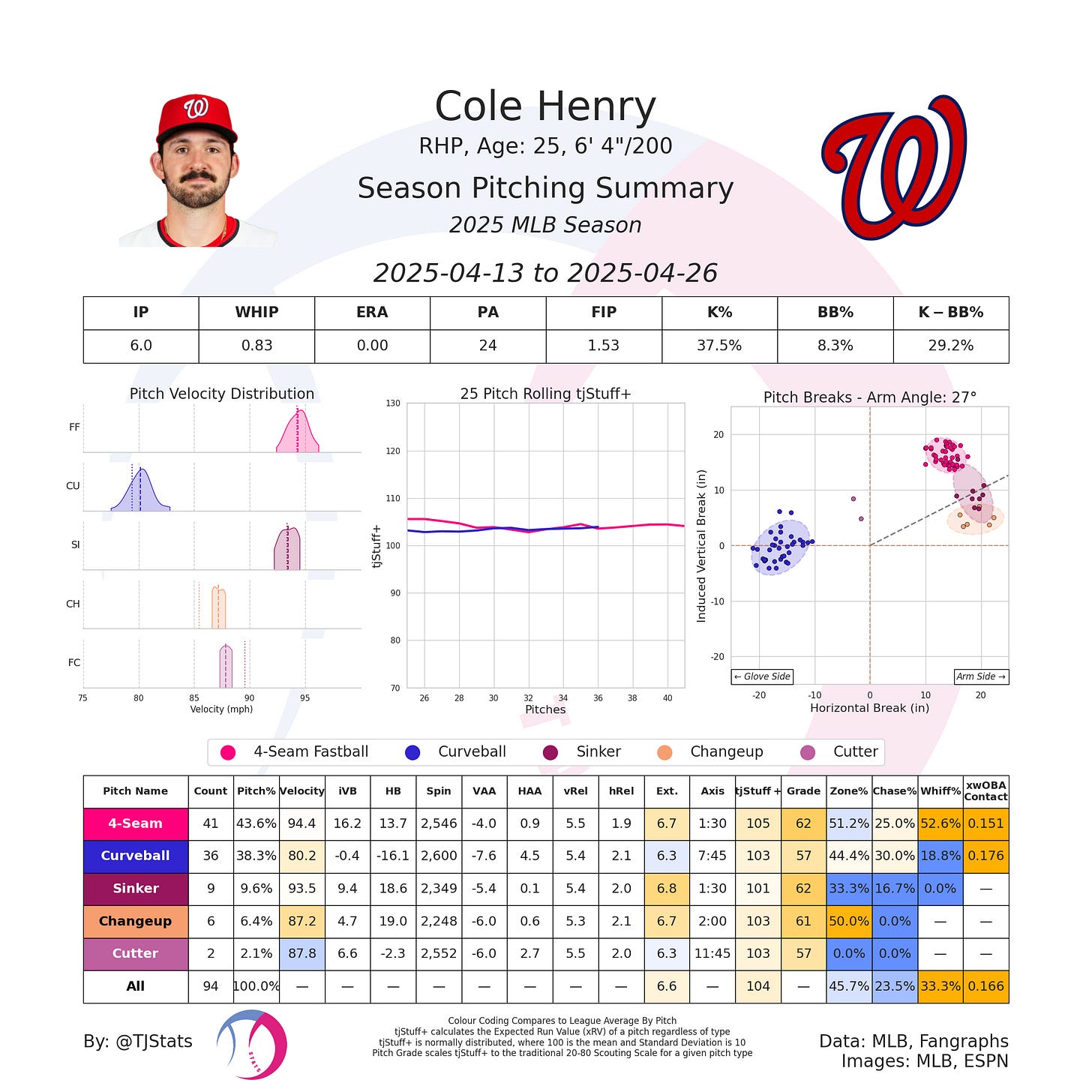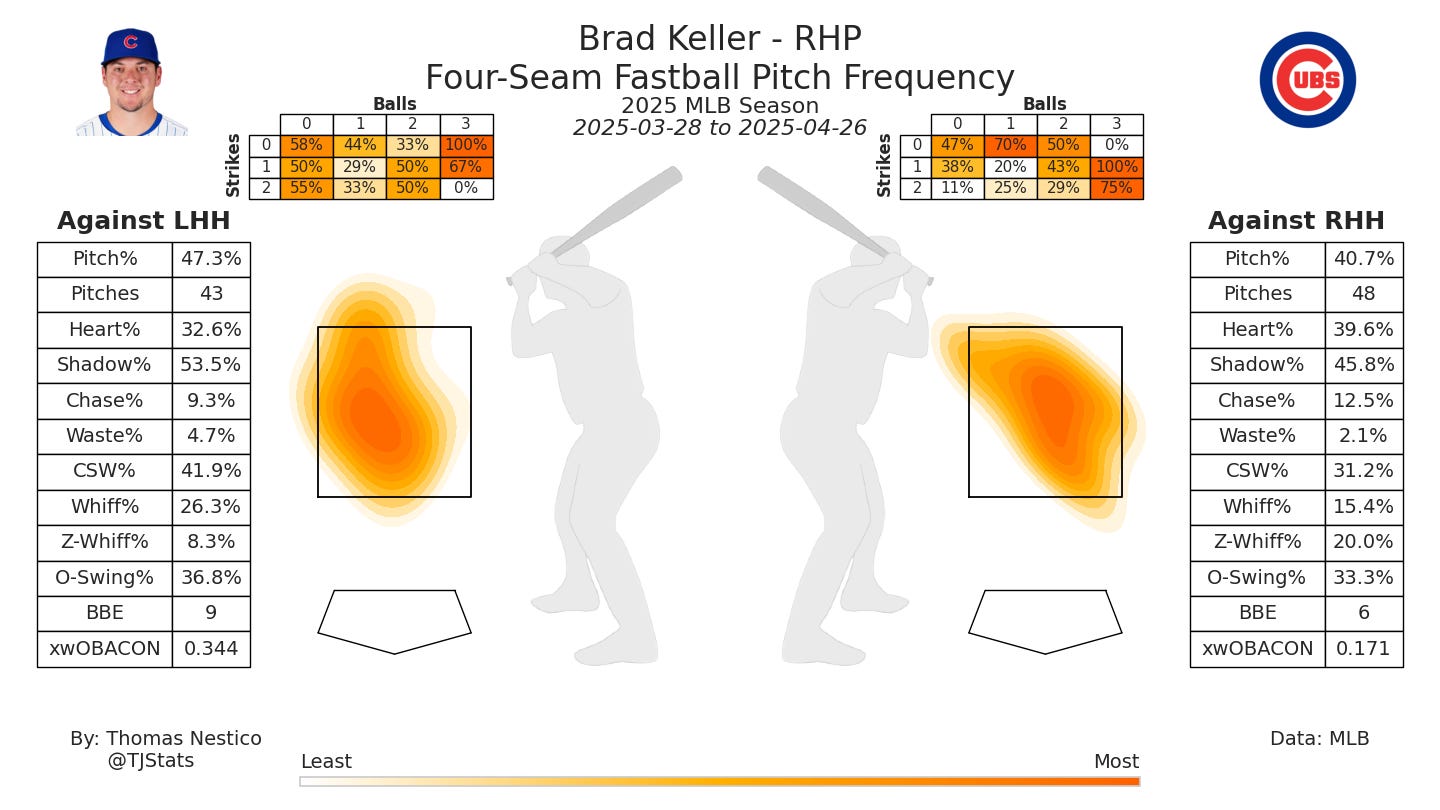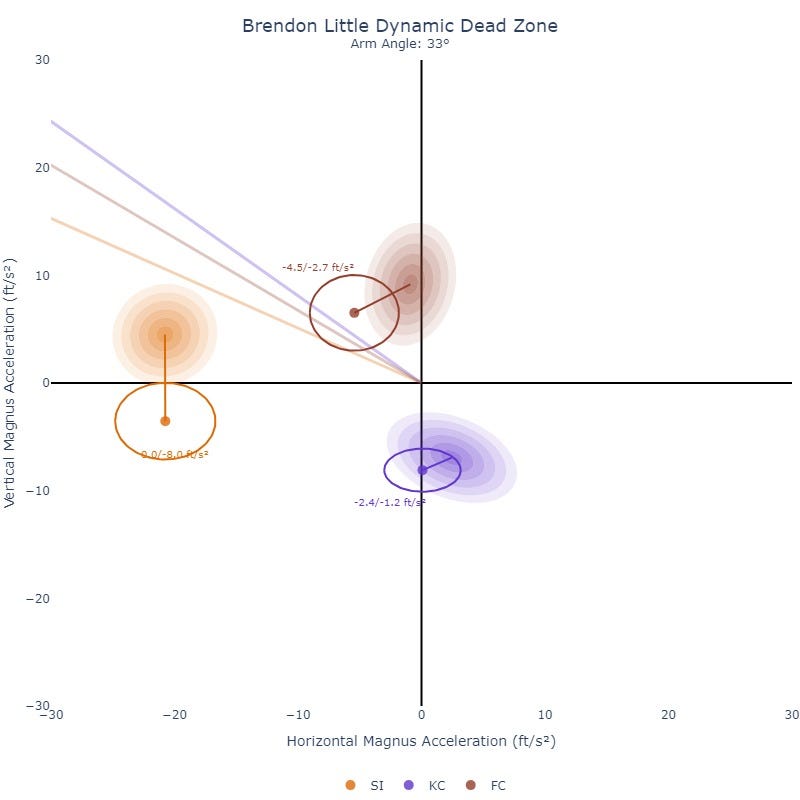5 More Relievers to Put on Your Radar
Brad Keller, Cole Henry, Louis Varland, Gabe Speier, Brendon Little
With the 2025 Season a few weeks in, let’s take a look at 5 more relief pitchers that have impressed thus far and are due for career years!
Cole Henry
Cole Henry has looked unstoppable in his first go at the big leagues. He is running a 52.6 Whiff% on his fastball thanks to some incredible command while backing it up with an awesome shape. He gets well above average ride on the pitch from his low 3/4 slot and his tendency to locate it high in the zone makes it a troublesome offering for batters. Its -4.0° VAA gives it a deceptive approach to the plate as it whizzes right over bats due to its lack of drop.
An underrated aspect of his fastball is its arm-side movement. It’s combination of ride and run gives the pitch a good amount of unexpected movement which causes batters to swing right under the pitch. For example: Tyler O’Neill.
Henry has been effective despite the lack of results on his secondaries. Each of his remaining offerings have strong characteristics which portend well for future production. His curveball (sweeper) gets a ton of glove-side movement while his changeup’s vertical separation from his fastball should make it a whiff-inducing weapon against LHH.
Upholding his fastball command will be the most important part to maintaining Henry’s current success. Once his curveball and changeup start to click, we are looking at a potential medium-to-high leverage arm for the Nationals.
Brad Keller
Brad Keller has a 5.19 ERA over his past 5 seasons, so I wouldn’t fault you for being confused about his inclusion in this article. Heck, he has a 5.56 ERA to start the season! However, Keller has looked the best he has ever done, and doing so with some very encouraging underlying traits.
It is Keller’s first season being a fulltime RP, which makes an increase in velocity not too surprising. However, his fastball is up +3 MPH while exhibiting more ride and more consistent movement compared to last season. It still falls under the umbrella of “Cubs Fastball”, which are typically known for their cut-ride shape, so I wouldn’t expect many whiffs, but the quality contact allowed has been excellent. Batters struggle to barrel up the pitch while Keller fills the zone with it.
The next big change for Keller was his sweeper. It is averaging 86 MPH with 16” glove-side movement and +3” iVB. This combination of movement and velocity is rare and helps the offering grade out at an exceptional 125 tjStuff+. Keller’s changeup has also been a revelation this season. Sitting in the low 90s, it plays off his fastball well thanks to its movement differential.
He has a very manufactured approach depending on the batter’s handedness. Against both LHH and RHH, he goes with an even dose of fastballs and sliders, while he exclusively throws his changeup to LHH and sweeper & sinker to RHH. This approach, along with the massive increase in stuff makes Keller a frustrating at bat. I expect him to be one of the Cubs best bullpen arms moving forward.
Louis Varland
Another SP turned RP approaches. Louis Varland has been the bane of Twins fans in recent seasons. Varland’s inconsistencies as a starter prevented him from sticking in the rotation long-term and now a crowded pipeline has forced him into a bullpen role, where he looks great!
Varland, like Keller, has seen a +3 MPH bump in velocity this season. Varland always had strong shapes on his pitches, and now all of them are harder than ever before. The most impactful result of this increase in velocity is how awesome his knuckle curveball looks. His knuckle curve has a “deathball” shape, meaning that it exhibits minimal horizontal movement while having the -4 to -10” of iVB. Now sitting in the upper 80s, its whiff-inducing ability skyrocketed, starting of the 2025 season with a 48.0 Whiff%.
Varland’s stuff looks exceptional, and he is doing a solid job at commanding each of his offerings well. I expect his strong strikeout rate to hold as he continues to succeed as a fulltime reliever.
Gabe Speier
Gabe Speier has been a beast in the Mariners bullpen this season. He currently holds a 0.77 ERA backed up by 2.35 FIP and 30.2 K-BB% while working out of high leverage situations for Seattle. What really makes Speier’s dominant is his fastball. It sits in the mid 90s where he generates above average ride for his slot. He paints the offering high in the zone, which allows its lack of drop evade bats as batters swing right under it.
To combat LHH, Speier relies on his sinker to induce weak contact. It also sits in the mid 90s, where its running action plays very well in the inner third of the plate. I won’t expect too many whiffs to come from the offering, but its ability to generate chases and poor contact makes it an extremely effective weapon. To round out his pitch mix, Speier tosses a tight 2-plane slider while ahead in the count and to put away batters.
Speier has showcased some excellent command this season, and it has elevated his arsenal to an elite level. Pitching in Seattle can only help Speier, but it looks like he doesn’t need any assistance to be a shutdown reliever for the Mariners.
Brendon Little
Brendon Little has one of the nastiest sinkers in baseball. The “Dynamic Dead Zone” plot below from Pitch Profiler illustrates how much “unexpected” movement Little gets on his sinker. Given his arm slot, you would expect his sinker to live between +2” to +6” iVB, meaning that is has decent depth, but nothing too unexpected. However, Little’s sinker gets a ton more drop, averaging -2” iVB, making it one of the most “sinkiest” sinkers in the league.
It is no surprise given its incredible depth that batters simply flail at the offering. It is running a 45.2 Whiff% while living at the bottom of the zone. Just take a look at this reaction from Rafael Devers on this strikeout:
Not only does Little have a wicked sinker, he supplements it with a disgusting knuckle curveball. Similar to Varland’s, this pitch falls under the “deathball” classification. Its higher velocity paired with a considerable amount of drop makes it a whiff generating machine. It has a laughable 69.2 Whiff% thus far, and induces some awkward swings like this:
Little has been one of the best LHRP in baseball this season, and I don’t see that changing anytime soon. A lefty with such astonishing deception will always be a nuisance vs LHH, and he has the stuff to excel against RHH as well. He is a blooming stud in the Blue Jays bullpen.
Follow me on Twitter: @TJStats
Follow me on BlueSky: @tjstats.ca
Consider Supporting me on Patreon: TJStats












